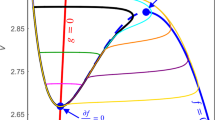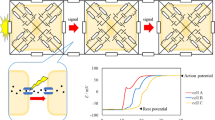Abstract
This work is motivated by the observation of remarkably slow firing in the uncoupled Hodgkin–Huxley model, depending on parameters τ h , τ n that scale the rates of change of the gating variables. After reducing the model to an appropriate nondimensionalized form featuring one fast and two slow variables, we use geometric singular perturbation theory to analyze the model’s dynamics under systematic variation of the parameters τ h , τ n , and applied current I. As expected, we find that for fixed (τ h , τ n ), the model undergoes a transition from excitable, with a stable resting equilibrium state, to oscillatory, featuring classical relaxation oscillations, as I increases. Interestingly, mixed-mode oscillations (MMO’s), featuring slow action potential generation, arise for an intermediate range of I values, if τ h or τ n is sufficiently large. Our analysis explains in detail the geometric mechanisms underlying these results, which depend crucially on the presence of two slow variables, and allows for the quantitative estimation of transitional parameter values, in the singular limit. In particular, we show that the subthreshold oscillations in the observed MMO patterns arise through a generalized canard phenomenon. Finally, we discuss the relation of results obtained in the singular limit to the behavior observed away from, but near, this limit.
Similar content being viewed by others
References
Benoıt E (1983) Systèmes lents-rapides dans R 3 et leur canards. Astérisque 109-110:159–191
Brøns M, Krupa M, Wechselberger M (2006) Mixed mode oscillations due to the generalized canard phenomenon. Fields Inst Commun 49:39–63
Doi S, Inoue J, Kumagai S (2004) Chaotic spiking in the Hodgkin Huxley nerve model with slow inactivation of the sodium current. J Integr Neurosci 3:207–225
Doi S, Kumagai S (2001) Nonlinear dynamics of small-scale biophysical neural networks. In: Poznanski R (ed) Biophysical neural networks: foundations of integrative neuroscience, Mary Ann Liebert Inc.
Doi S, Kumagai S (2005) Generation of very slow rhythms and chaos near the Hopf bifurcation in single neuron models. J Comp Neurosci 19:325–356
Doi S, Nabetani S, Kumagai S (2001) Complex nonlinear dynamics of the Hodgkin–Huxley equations. Biol Cybern 85:51–64
Drover J, Rubin J, Su J, Ermentrout B (2004) Analysis of a canard mechanism by which excitatory synaptic coupling can synchronize neurons at low firing frequencies. SIAM J Appl Math 65:69–92
Ermentrout B (2002) Simulating, analyzing, and animating dynamical systems. SIAM, Philadelphia
Fenichel N (1979) Geometric singular perturbation theory. J Diff Eq 31:53–98
FitzHugh R (1960) Thresholds and plateaus in the Hodgkin–Huxley nerve equations. J Gen Physiol 43:867–896
Guckenheimer J, Haiduc R (2005) Canards at folded nodes. Mosc Math J 5:91–103
Guckenheimer J, Harris-Warrick R, Peck J, Willms A (1997) Bifurcation, bursting, and spike frequency adaptation. J Comp Neurosci 4:257–277
Guckenheimer J, Oliva R (2002) Chaos in the Hodgkin–Huxley model. SIAM J Appl Dyn Sys 1:105–114
Guckenheimer J, Wechselberger M, Young L-S (2005) Chaotic attractors of relaxation oscillators. Nonlinearity 19:701–720
Guckenheimer J, Willms A (2000) Asymptotic analysis of subcritical Hopf-homoclinic bifurcation. Physica D 139:195–216
Hodgkin A, Huxley A (1952) A quantitative description of membrane current and its application to conduction and excitation in nerve. J Physiol (London) 117:500–544
Jones C (1995) Geometric singular perturbation theory, in dynamical systems. Lecture Notes Math 1609. Springer, Heidelberg, pp 44–120
Milik A, Szmolyan P, Loeffelmann H, Groeller E (1998) Geometry of mixed-mode oscillations in the 3d autocatalator. Int J Bif Chaos 8:505–519
Moehlis J (2006) Canards for a reduction of the Hodgkin–Huxley equation. J Math Biol 52:141–153
Nagumo J, Arimoto S, Yoshizawa S (1962) An active pulse transmission line simulating nerve axon. Proc. IRE 50:2061–2070
Rinzel J (1985) Excitation dynamics: insights from simplified membrane models. Fed. Proc. 44:2944–2946
Rinzel J, Ermentrout B (1989) Analysis of neural excitability and oscillations. In: Koch C, Segev I (eds) Methods in neuronal modeling: from synapses to networks. MIT Press, Cambridge
Rinzel J, Miller R (1980) Numerical calculation of stable and unstable periodic solutions to the Hodgkin–Huxley equations. Math Biosci 49:27–59
Rubin J (2005) Surprising effects of synaptic excitation. J Comp Neurosci 18:333–342
Szmolyan P, Wechselberger M (2001) Canards in \({\mathbb{R}}^3\) . J Diff Eq 177: 419–453
Szmolyan P, Wechselberger M (2004) Relaxation oscillations in \({\mathbb{R}}^3\) . J Diff Eq 200:69–104
Wechselberger M (2005a) Existence and bifurcation of canards in \({\mathbb{R}}^3\) in the case of a folded node. SIAM J Appl Dyn Sys 4:101–139
Wechselberger M (2005b) Poincare maps for relaxation oscillations in \({\mathbb{R}}^3\) - invariant manifolds, canards and turning points. In: Proceedings of Equadiff 03, Hasselt, Belgium
Author information
Authors and Affiliations
Corresponding author
Rights and permissions
About this article
Cite this article
Rubin, J., Wechselberger, M. Giant squid-hidden canard: the 3D geometry of the Hodgkin–Huxley model. Biol Cybern 97, 5–32 (2007). https://doi.org/10.1007/s00422-007-0153-5
Received:
Accepted:
Published:
Issue Date:
DOI: https://doi.org/10.1007/s00422-007-0153-5




